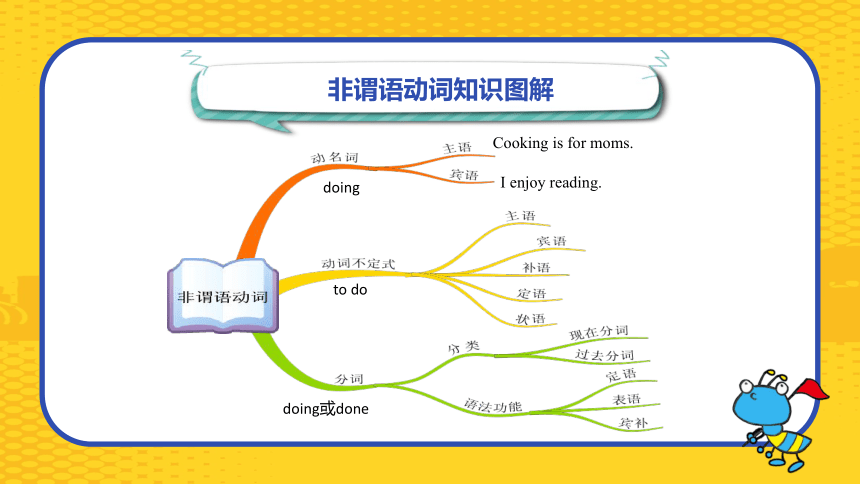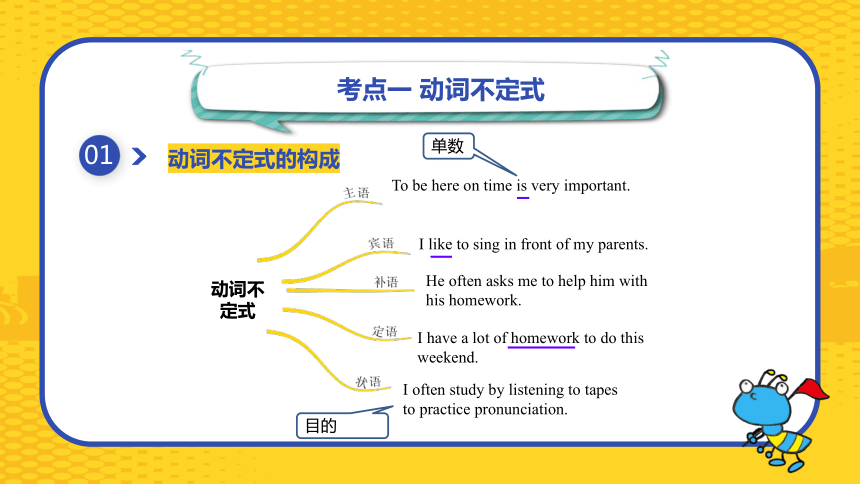中考英语二轮语法总复习课件 专题十 非谓语动词(共37张PPT)
文档属性
| 名称 | 中考英语二轮语法总复习课件 专题十 非谓语动词(共37张PPT) |  | |
| 格式 | zip | ||
| 文件大小 | 883.1KB | ||
| 资源类型 | 试卷 | ||
| 版本资源 | 通用版 | ||
| 科目 | 英语 | ||
| 更新时间 | 2022-09-03 22:38:27 | ||
图片预览












文档简介
(共37张PPT)
非谓语动词主要是指在句中不能充当谓语,没有人称和数的变化,而只能充当其语法功能的动词。
主要有三种形式:动名词、动词不定式和分词。
考
语
法
总
复
专题十 非谓语动词
习
中
非谓语动词的定义
01
非谓语动词主要是指在句中不能充当谓语,没有人称和数的变化,而只能充当其语法功能的动词。主要有三种形式:动名词、动词不定式和分词。
动词不定式
I want to see you this afternoon.
Have you finished doing your homework
动名词
I’ve known the boy named Mike well.
分词
非谓语动词知识图解
01
Cooking is for moms.
I enjoy reading.
doing
to do
doing或done
考点一 动词不定式
01
动词不定式的构成
To be here on time is very important.
I like to sing in front of my parents.
He often asks me to help him with his homework.
I have a lot of homework to do this weekend.
I often study by listening to tapes to practice pronunciation.
动词不定式
目的
单数
考点一 动词不定式
01
动词不定式的构成
英语里的不定式分为带to的不定式(to do)和不带to的不定式(do或动词原形)。动词不定式没有人称和数的变化。
(1)动词不定式的肯定式: to+动词原形。有时可以省略to,这里的to是不定式符号,本身无词义。
(2)动词不定式的否定形式:not+(to+)动词原形。
考点一 动词不定式
02
动词不定式的基本用法
用法 说明 例词
作主语 动词不定式作主语时,常用it作形式主语,而将真正的主语放在句末,避免句子头重脚轻 To learn English well is important. = It is important to learn English well. 学好英语是很重要的
第三人称单数形式 如果要说明不定式表示的动作的执行者,可以在不定式前加for sb. 其结构为 It+be+adj.+for sb.+to do sth. It is important for you to learn English well.学好英语对你来说很重要。
考点一 动词不定式
02
动词不定式的基本用法
用法 说明 例词
作主语 表示人的品质特征、主观情感或态度的形容词(例:nice, kind, good, wise, polite , silly, clever, wrong, careful 等)作表语时,在定式之前加of sb.,用来说明动作的执行者。其结构为It be+adj. +of sb.+to do sth. It's very kind of you to help me.你能来帮我真好。
It's not polite of him to speak to old people like that.他像那样和老人家说话,很不礼貌。
第三人称单数形式 两个或两个以上的动词不定式并列时,第一个不定式带to,后面的不定式通常省略to To go to sleep early and get up early is a good habit.早睡早起是一种好习惯。
考点一 动词不定式
02
动词不定式的基本用法
用法 说明 例词
作宾语 常见的及物动词有: agree, afford, begin, choose, continue, decide, expect, fail, forget, hate, help, hope, like, learn, offer, manage, mean, need, pretend, promise, refuse, plan, try, prefer start等 I couldn't afford to buy a digital camera then. 那时我买不起数码照相机。
He wanted to go to the countryside to see his grandparents.他想去乡下看他的爷爷奶奶。
第三人称单数形式 在find, think后跟不定式作宾语时,常用it作形式宾语,而将真正的宾语放在后面。 I find it difficult to read English stories.我发现读英文故事很难。
考点一 动词不定式
02
动词不定式的基本用法
用法 说明 例词
作宾语补足语 常见的动词有: want, ask, allow, tell, teach, get, advise, warn, force ,encourage, help, order, invite等 My mother encourages me to think it over carefully.我妈妈鼓励我仔细考虑它。
第三人称单数形式 一些使役动词和感官动词后接不带to的不定式作宾补。但是,变为被动语态时必须加上to I often hear Li Ming sing in the evening.=Li Ming is often heard to sing in the evening.我经常听到李明在傍晚时唱歌。
动词help后面的不定式,可以带to,也可以不带to You must help me ( to) do my housework this afternoon.今天下午必须帮助我做家务。
考点一 动词不定式
02
动词不定式的基本用法
用法 说明 例词
作定语 要放在被修饰的名词之后,作后置定语 I have some clothes to wash.我有一些衣服要洗。I have too much homework to do.我有太多的作业要做
第三人称单数形式 不及物动词的不定式作定语,与被修饰的词有逻辑上的被动关系时,不定式后面的介词通常不能省略;不定式修饰名词time/place/way 时,其后的介词则常省略 He is looking for a room to live in.他正在找房子住。My grandma used to have no place to live (in).我的奶奶过去没地方住。
不定式修饰复合不定代词时放在后面,即 something/anything/nothing...+不定式 I had something cold to drink.我喝了一些冰的东西.
考点一 动词不定式
02
动词不定式的基本用法
用法 说明 例词
作状语 位于句首或句末,作目的状语 To be a good student, one must study hard.要成为好学生,必须努力学习。
第三人称单数形式 不定式放在表示心理状态或情绪的形容词后面(即"be+形容词+to do"结构),作原因状语 We are sorry to trouble you.我们很抱歉去打扰你。I'm so glad to see you.见到你真高兴。
常与enough或too连用,作结果状语 He is old enough to go to school.他(年龄)足够大去上学了。She is too young to go to school.她太小了,还不能去上学。
考点一 动词不定式
02
动词不定式的基本用法
用法 说明 例词
作表语 通常对系动词前面的名词进行解释说明 His dream is to be a doctor like Zhong Nanshan.
他的梦想是成为一名像钟南山那样的医生。
考点一 动词不定式
归纳总结
(1)常见的含动词不定式的句式:
①Why not do sth. 为什么不去做某事呢
②It takes/took+sb. + some time +to do sth.
做某事花费某人多长时间。
③It's one's turn+to do sth. 轮到某人做某事了。
④It's best+not to do sth.最好不做某事。
(2)不定式常放在疑问词what, which, when, where, how后面,
在句子中作主语、宾语、表语等。例:
He didn‘t tell me where to go.
= He didn’t tell me where he would go.
03
ci
考点一 动词不定式
即时训练
用所给词的适当形式填空
① I decide __________ (find) a good job in a foreign company after I graduate from school.
② He found it hard ___________(catch) up with his classmates.
04
to find
to catch
考点一 动词不定式
01
即时训练
用所给词的适当形式填空
③ Father expects me ______________(not play ) computer games before finishing my homework.
④ All the children like Mr. White very much because he often makes them ____________(laugh).
⑤ We have two rooms ___________(live) in, but I can't decide which one _____________(choose).
04
not to play
laugh
to live
to choose
考点二 动名词
01
动名词的构成
1.肯定式
在动词原形后面加-ing构成,写作doing。它具有名词的性质,在句子中可以作主语、表语、宾语和定语,同时又保留了动词的性质,可以有自己的宾语和状语。
2.否定式
由“not+动词-doing 形式”构成,写作not doing。
考点二 动名词
02
动名词的基本用法
用法 说明 例词
作主语 动名词在句中作主语时,谓语动词用单数。有时可用it作形式主语,将动名词放在句末 Swimming is good for health.游泳对健康有好处。
It's interesting playing with children.和孩子们一起玩很有趣。
作宾语 动词enjoy, practice, finish, mind, miss, keep, suggest, imagine, consider 等后面接动名词作宾语 He practices speaking English every day.他每天练习说英语。
动名词放在介词后面或某些含有介词的短语动词后面,作宾语。如: feel, like, give up, think of, take part in, spend time (in), be interested in, be proud of, be used to等 We are proud of being Chinese.作为中国人我们很自豪。
Anne is used to living in this city.安妮习惯生活在这座城市里。
考点二 动名词
02
动名词的基本用法
用法 说明 例词
作定语 通常位于名词前 There is a swimming pool.有一个游泳池。They found another hiding place.
他们找到了另外一个藏身之处。
作表语 表示主语具有抽象名词特性 Seeing is believing.眼见为实。
考点二 动名词
归纳总结
(1)英语中有一些动词(短语)后面常跟动名词作宾语。我们可按下面的顺口溜记忆:
考虑建议盼原谅(consider, suggest/advise, look forward to, excuse, pardon)
承认推迟没得想(admit, delay/put off, fancy)
避免错过继续练(avoid, miss, keep/keep on, practice)
否认完成能欣赏(deny, finish, enjoy, appreciate)
不禁介意与逃亡(can't help, mind, escape)
禁止冒险凭想象( forbid, risk, imagine)
03
考点二 动名词
归纳总结
(2)下列短语中的to为介词,后面应加动名词作宾语。
make contributions to 为做贡献
devote oneself to 致力于
look forward to 期盼
(3) need/require/want +doing, 相当于接不定式的被动式(to be done)。
The flowers need watering.
= The flowers need to be watered.
花需要浇水了。
03
考点二 动名词
归纳总结
部分动词后接不定式与动名词的区别
03
用法 说明 例词
stop stop to do sth. 停下来去做某事 Stop to think about it for a moment.
停下来想一下这件事。
作表语 stop doing sth. 停止做某事 Stop talking, please.
请停止说话。
remember remember to do sth. 记住要做某事(动作未发生) Please remember to post my letter.
请记得把我的信寄走。
remember doing sth. 记得曾做过某事(动作已发生) I remember posting your letter.
我记得把你的信寄出去了。
考点二 动名词
归纳总结
部分动词后接不定式与动名词的区别
03
用法 说明 例词
forgot forget to do sth. 忘记做某事(动作未发生) I forgot to bring my homework.
我忘记带作业了。
作表语 forget doing sth. 忘记做过某事(动作已发生) I forgot bringing my homework.
我忘记已经把作业带来了。
try try to do sth. 努力去做某事 Please try to do better next time.
下次请设法做得更好些。
try doing sth. 试着做某事 He tried speaking English to us.
他试着用英语和我们谈话。
考点二 动名词
归纳总结
部分动词后接不定式与动名词的区别
03
用法 说明 例词
go on go on to do sth. (做完一件事后)接着去做另外一件事 Go on to do the other exercises after you finish this one. 做完这个练习题后, 接着做其他的。
作表语 go on doing sth. 不停地做某事 He went on working until he was 91.
他一直工作到91岁。
allow allow sb. to do sth. 允许某人做某事 We don’t allow students to go out.
我们不允许学生外出。
allow doing sth. 允许做某事 We don’t allow smoking here.
我们不允许在这里吸烟
考点二 动名词
归纳总结
部分动词后接不定式与动名词的区别
03
用法 说明 例词
regret regret to do sth. 对要做某事感到遗憾(不做) I regret to have to do this, but I have no choice.
我很遗憾必须这样做,但是我没有选择。
作表语 regret doing sth. 对做过某事感到后悔(已做) I don’t regret telling her what I thought.
我不后悔告诉了她我的想法。
mean mean to do sth. 打算/想做某事 I meant to go, but my father would not allow me to. 我想去,但我父亲不肯让我去。
mean doing sth. 意味着做某事 Doing that means wasting time.
做那件事意味着浪费时间。
考点二 动名词
即时训练
用所给词的适当形式填空
①Before the beginning of 2025, we will finish __________(build) the schools.
②She says she doesn’t feel like __________ (go) out with you.
③Peter is busy _________ (work) at school, but he never forgets ____________ (do) exercise every day.
④___________(go) camping in the country is great fun.
04
building
going
working
to do
Going
考点二 动名词
即时训练
用所给词的适当形式填空
⑩Richard turned off the computer after he had finished _________ the e-mail.
A. write B. to write C. writing D. wrote
Most of the young people are quite interested in _________ the singer’s songs.
A. sing B. singing C. sang D. to sing
04
C
B
考点二 动名词
即时训练
用所给词的适当形式填空
The boy is looking forward to _______ a good time after the exam.
A. to have B. has C. having D. have
04
C
考点三 分词
01
分词的构成
He is the boy called Tom.
The boy sleeping there is Bob.
The thing is exciting.
He is pleased with me.
I heard him singing in the next room.
I had my hair cut yesterday.
过去分词,
现在分词,
动宾关系
主谓关系
动宾关系
主谓关系
性质、特征
状态
分词
考点三 分词
01
分词的构成
1.现在分词
由“动词原形+-ing"构成,写作doing。现在分词有主动、进行之意。
2.过去分词
由“动词原形+-ed” (基本形式,但也有不规则的形式),写作done。过去分词有被动、完成之意。
考点三 分词
分词的基本用法
02
用法 例句 说明
作定语 Do you know the girl standing under the tree 你认识站在树下面的那个女孩吗 现在分词作定语,其逻辑主语是它所修饰的词
作表语 Please hand in your written exercises.请交上你们的书面练习。 过去分词作定语,其逻辑宾语是它所修饰的词
作状语 The students went out of the classroom, talking and laughing. 学生们谈笑着走出了教室。 现在分词作状语时,其逻辑主语为句子的主语
考点三 分词
分词的基本用法
02
用法 例句 说明
作表语 The book was rather boring. 这本书相当枯燥乏味。 现在分词表示主语的性质、特征
作表语 The boy is too frightened to move. 这个男孩太害怕了,以至于不能动了。 过去分词表示某种状态
作补语 Don't keep us waiting for a longtime. 不要让我们等得太久。 现在分词作宾语补足语,宾语是它的逻辑主语
He'll have his hair cut after school. 放学后他要去理发。 过去分词作宾语补足语,宾语是它的逻辑宾语
考点三 分词
have sb./sth. do sth., have sb./sth. doing sth. 和have sth. done的区别
03
短语 用法 例句
have sb./sth. do sth. 让某人/物做某事 (不定式往往表示一次性的具体动作,且强调动作已经完成或尚未发生) The soldiers has the boy stand with his back to his father. 士兵们让这个男孩背对他的父亲站着。
have sb./sth. doing sth. 让某人/物一直做某事(现在分词所表示的动作往往具有持续进行的含义) The two men had their lights burning all night long. 那两个男人让灯通宵亮着。
have sth. done 让别人做某事(过去分词所表示的动作由他人来完成) The driver has his car washed once a week. 这个司机一周让人洗一次车。
考点三 分词
即时训练
04
用所给词的适当形式填空
The boy ____________ (stand) in the teachers’ office was found smoking yesterday.
Smartphones ____________ (make) by Huawei are getting more and more popular around the world.
The book ___________ (write) by Mo Yan is easy to read.
___________ (water) in time, the flowers couldn’t die.
standing
made
written
Watered
强化训练
即时训练
—Listen! Who is singing in the next room
—It must be Sally. I often hear her ________ there.
A. singing B. sings C. to sing D. sing
04
解析:考查非谓语动词。句意:—听,谁正在隔壁唱歌?—一定是萨莉。我经常听见她在那里唱歌。often“经常”。hear后加省略to的动词不定式,作宾语补足语,意为“听见某人做某事”,强调经常做或是做某事的过程。
答案: D
强化训练
即时训练
He explained again and again in order to make what he did ________.
A. understand B. understood
C. to understand D. understanding
04
解析:考查非谓语动词。句意:他反复解释,为的是让人理解他的所作所为。宾语部分what he did和选项中的动词存在被动关系,故应用过去分词。make …done意为“使……被……”,过去分词作宾语补足语。
答案: B
强化训练
即时训练
When I walked past the park yesterday morning, I saw some women _________(dance) there.
04
解析:考查非谓语动词。句意:昨天上午,当我走过公园的时候,看见一些妇女正在那儿跳舞。see sb doing sth. “看见某人正在做某事”。由题干中的When I walked past the park “当我走过公园的时候”,可知强调某一时刻正在发生的动作,所以应用现在分词,作宾语补足语。
答案: dancing
强化训练
即时训练
Mr. Sigmund Friend is used to_______________(处理) with all kinds of problems.
04
解析:西格蒙德弗莱德先生习惯于处理各种问题。be used to doing sth意为“习惯于做某事”,其中的to是介词,后接动词-ing形式,作介词宾语;deal with = do with意为“处理”。
答案: dealing/ doing
非谓语动词主要是指在句中不能充当谓语,没有人称和数的变化,而只能充当其语法功能的动词。
主要有三种形式:动名词、动词不定式和分词。
考
语
法
总
复
专题十 非谓语动词
习
中
非谓语动词的定义
01
非谓语动词主要是指在句中不能充当谓语,没有人称和数的变化,而只能充当其语法功能的动词。主要有三种形式:动名词、动词不定式和分词。
动词不定式
I want to see you this afternoon.
Have you finished doing your homework
动名词
I’ve known the boy named Mike well.
分词
非谓语动词知识图解
01
Cooking is for moms.
I enjoy reading.
doing
to do
doing或done
考点一 动词不定式
01
动词不定式的构成
To be here on time is very important.
I like to sing in front of my parents.
He often asks me to help him with his homework.
I have a lot of homework to do this weekend.
I often study by listening to tapes to practice pronunciation.
动词不定式
目的
单数
考点一 动词不定式
01
动词不定式的构成
英语里的不定式分为带to的不定式(to do)和不带to的不定式(do或动词原形)。动词不定式没有人称和数的变化。
(1)动词不定式的肯定式: to+动词原形。有时可以省略to,这里的to是不定式符号,本身无词义。
(2)动词不定式的否定形式:not+(to+)动词原形。
考点一 动词不定式
02
动词不定式的基本用法
用法 说明 例词
作主语 动词不定式作主语时,常用it作形式主语,而将真正的主语放在句末,避免句子头重脚轻 To learn English well is important. = It is important to learn English well. 学好英语是很重要的
第三人称单数形式 如果要说明不定式表示的动作的执行者,可以在不定式前加for sb. 其结构为 It+be+adj.+for sb.+to do sth. It is important for you to learn English well.学好英语对你来说很重要。
考点一 动词不定式
02
动词不定式的基本用法
用法 说明 例词
作主语 表示人的品质特征、主观情感或态度的形容词(例:nice, kind, good, wise, polite , silly, clever, wrong, careful 等)作表语时,在定式之前加of sb.,用来说明动作的执行者。其结构为It be+adj. +of sb.+to do sth. It's very kind of you to help me.你能来帮我真好。
It's not polite of him to speak to old people like that.他像那样和老人家说话,很不礼貌。
第三人称单数形式 两个或两个以上的动词不定式并列时,第一个不定式带to,后面的不定式通常省略to To go to sleep early and get up early is a good habit.早睡早起是一种好习惯。
考点一 动词不定式
02
动词不定式的基本用法
用法 说明 例词
作宾语 常见的及物动词有: agree, afford, begin, choose, continue, decide, expect, fail, forget, hate, help, hope, like, learn, offer, manage, mean, need, pretend, promise, refuse, plan, try, prefer start等 I couldn't afford to buy a digital camera then. 那时我买不起数码照相机。
He wanted to go to the countryside to see his grandparents.他想去乡下看他的爷爷奶奶。
第三人称单数形式 在find, think后跟不定式作宾语时,常用it作形式宾语,而将真正的宾语放在后面。 I find it difficult to read English stories.我发现读英文故事很难。
考点一 动词不定式
02
动词不定式的基本用法
用法 说明 例词
作宾语补足语 常见的动词有: want, ask, allow, tell, teach, get, advise, warn, force ,encourage, help, order, invite等 My mother encourages me to think it over carefully.我妈妈鼓励我仔细考虑它。
第三人称单数形式 一些使役动词和感官动词后接不带to的不定式作宾补。但是,变为被动语态时必须加上to I often hear Li Ming sing in the evening.=Li Ming is often heard to sing in the evening.我经常听到李明在傍晚时唱歌。
动词help后面的不定式,可以带to,也可以不带to You must help me ( to) do my housework this afternoon.今天下午必须帮助我做家务。
考点一 动词不定式
02
动词不定式的基本用法
用法 说明 例词
作定语 要放在被修饰的名词之后,作后置定语 I have some clothes to wash.我有一些衣服要洗。I have too much homework to do.我有太多的作业要做
第三人称单数形式 不及物动词的不定式作定语,与被修饰的词有逻辑上的被动关系时,不定式后面的介词通常不能省略;不定式修饰名词time/place/way 时,其后的介词则常省略 He is looking for a room to live in.他正在找房子住。My grandma used to have no place to live (in).我的奶奶过去没地方住。
不定式修饰复合不定代词时放在后面,即 something/anything/nothing...+不定式 I had something cold to drink.我喝了一些冰的东西.
考点一 动词不定式
02
动词不定式的基本用法
用法 说明 例词
作状语 位于句首或句末,作目的状语 To be a good student, one must study hard.要成为好学生,必须努力学习。
第三人称单数形式 不定式放在表示心理状态或情绪的形容词后面(即"be+形容词+to do"结构),作原因状语 We are sorry to trouble you.我们很抱歉去打扰你。I'm so glad to see you.见到你真高兴。
常与enough或too连用,作结果状语 He is old enough to go to school.他(年龄)足够大去上学了。She is too young to go to school.她太小了,还不能去上学。
考点一 动词不定式
02
动词不定式的基本用法
用法 说明 例词
作表语 通常对系动词前面的名词进行解释说明 His dream is to be a doctor like Zhong Nanshan.
他的梦想是成为一名像钟南山那样的医生。
考点一 动词不定式
归纳总结
(1)常见的含动词不定式的句式:
①Why not do sth. 为什么不去做某事呢
②It takes/took+sb. + some time +to do sth.
做某事花费某人多长时间。
③It's one's turn+to do sth. 轮到某人做某事了。
④It's best+not to do sth.最好不做某事。
(2)不定式常放在疑问词what, which, when, where, how后面,
在句子中作主语、宾语、表语等。例:
He didn‘t tell me where to go.
= He didn’t tell me where he would go.
03
ci
考点一 动词不定式
即时训练
用所给词的适当形式填空
① I decide __________ (find) a good job in a foreign company after I graduate from school.
② He found it hard ___________(catch) up with his classmates.
04
to find
to catch
考点一 动词不定式
01
即时训练
用所给词的适当形式填空
③ Father expects me ______________(not play ) computer games before finishing my homework.
④ All the children like Mr. White very much because he often makes them ____________(laugh).
⑤ We have two rooms ___________(live) in, but I can't decide which one _____________(choose).
04
not to play
laugh
to live
to choose
考点二 动名词
01
动名词的构成
1.肯定式
在动词原形后面加-ing构成,写作doing。它具有名词的性质,在句子中可以作主语、表语、宾语和定语,同时又保留了动词的性质,可以有自己的宾语和状语。
2.否定式
由“not+动词-doing 形式”构成,写作not doing。
考点二 动名词
02
动名词的基本用法
用法 说明 例词
作主语 动名词在句中作主语时,谓语动词用单数。有时可用it作形式主语,将动名词放在句末 Swimming is good for health.游泳对健康有好处。
It's interesting playing with children.和孩子们一起玩很有趣。
作宾语 动词enjoy, practice, finish, mind, miss, keep, suggest, imagine, consider 等后面接动名词作宾语 He practices speaking English every day.他每天练习说英语。
动名词放在介词后面或某些含有介词的短语动词后面,作宾语。如: feel, like, give up, think of, take part in, spend time (in), be interested in, be proud of, be used to等 We are proud of being Chinese.作为中国人我们很自豪。
Anne is used to living in this city.安妮习惯生活在这座城市里。
考点二 动名词
02
动名词的基本用法
用法 说明 例词
作定语 通常位于名词前 There is a swimming pool.有一个游泳池。They found another hiding place.
他们找到了另外一个藏身之处。
作表语 表示主语具有抽象名词特性 Seeing is believing.眼见为实。
考点二 动名词
归纳总结
(1)英语中有一些动词(短语)后面常跟动名词作宾语。我们可按下面的顺口溜记忆:
考虑建议盼原谅(consider, suggest/advise, look forward to, excuse, pardon)
承认推迟没得想(admit, delay/put off, fancy)
避免错过继续练(avoid, miss, keep/keep on, practice)
否认完成能欣赏(deny, finish, enjoy, appreciate)
不禁介意与逃亡(can't help, mind, escape)
禁止冒险凭想象( forbid, risk, imagine)
03
考点二 动名词
归纳总结
(2)下列短语中的to为介词,后面应加动名词作宾语。
make contributions to 为做贡献
devote oneself to 致力于
look forward to 期盼
(3) need/require/want +doing, 相当于接不定式的被动式(to be done)。
The flowers need watering.
= The flowers need to be watered.
花需要浇水了。
03
考点二 动名词
归纳总结
部分动词后接不定式与动名词的区别
03
用法 说明 例词
stop stop to do sth. 停下来去做某事 Stop to think about it for a moment.
停下来想一下这件事。
作表语 stop doing sth. 停止做某事 Stop talking, please.
请停止说话。
remember remember to do sth. 记住要做某事(动作未发生) Please remember to post my letter.
请记得把我的信寄走。
remember doing sth. 记得曾做过某事(动作已发生) I remember posting your letter.
我记得把你的信寄出去了。
考点二 动名词
归纳总结
部分动词后接不定式与动名词的区别
03
用法 说明 例词
forgot forget to do sth. 忘记做某事(动作未发生) I forgot to bring my homework.
我忘记带作业了。
作表语 forget doing sth. 忘记做过某事(动作已发生) I forgot bringing my homework.
我忘记已经把作业带来了。
try try to do sth. 努力去做某事 Please try to do better next time.
下次请设法做得更好些。
try doing sth. 试着做某事 He tried speaking English to us.
他试着用英语和我们谈话。
考点二 动名词
归纳总结
部分动词后接不定式与动名词的区别
03
用法 说明 例词
go on go on to do sth. (做完一件事后)接着去做另外一件事 Go on to do the other exercises after you finish this one. 做完这个练习题后, 接着做其他的。
作表语 go on doing sth. 不停地做某事 He went on working until he was 91.
他一直工作到91岁。
allow allow sb. to do sth. 允许某人做某事 We don’t allow students to go out.
我们不允许学生外出。
allow doing sth. 允许做某事 We don’t allow smoking here.
我们不允许在这里吸烟
考点二 动名词
归纳总结
部分动词后接不定式与动名词的区别
03
用法 说明 例词
regret regret to do sth. 对要做某事感到遗憾(不做) I regret to have to do this, but I have no choice.
我很遗憾必须这样做,但是我没有选择。
作表语 regret doing sth. 对做过某事感到后悔(已做) I don’t regret telling her what I thought.
我不后悔告诉了她我的想法。
mean mean to do sth. 打算/想做某事 I meant to go, but my father would not allow me to. 我想去,但我父亲不肯让我去。
mean doing sth. 意味着做某事 Doing that means wasting time.
做那件事意味着浪费时间。
考点二 动名词
即时训练
用所给词的适当形式填空
①Before the beginning of 2025, we will finish __________(build) the schools.
②She says she doesn’t feel like __________ (go) out with you.
③Peter is busy _________ (work) at school, but he never forgets ____________ (do) exercise every day.
④___________(go) camping in the country is great fun.
04
building
going
working
to do
Going
考点二 动名词
即时训练
用所给词的适当形式填空
⑩Richard turned off the computer after he had finished _________ the e-mail.
A. write B. to write C. writing D. wrote
Most of the young people are quite interested in _________ the singer’s songs.
A. sing B. singing C. sang D. to sing
04
C
B
考点二 动名词
即时训练
用所给词的适当形式填空
The boy is looking forward to _______ a good time after the exam.
A. to have B. has C. having D. have
04
C
考点三 分词
01
分词的构成
He is the boy called Tom.
The boy sleeping there is Bob.
The thing is exciting.
He is pleased with me.
I heard him singing in the next room.
I had my hair cut yesterday.
过去分词,
现在分词,
动宾关系
主谓关系
动宾关系
主谓关系
性质、特征
状态
分词
考点三 分词
01
分词的构成
1.现在分词
由“动词原形+-ing"构成,写作doing。现在分词有主动、进行之意。
2.过去分词
由“动词原形+-ed” (基本形式,但也有不规则的形式),写作done。过去分词有被动、完成之意。
考点三 分词
分词的基本用法
02
用法 例句 说明
作定语 Do you know the girl standing under the tree 你认识站在树下面的那个女孩吗 现在分词作定语,其逻辑主语是它所修饰的词
作表语 Please hand in your written exercises.请交上你们的书面练习。 过去分词作定语,其逻辑宾语是它所修饰的词
作状语 The students went out of the classroom, talking and laughing. 学生们谈笑着走出了教室。 现在分词作状语时,其逻辑主语为句子的主语
考点三 分词
分词的基本用法
02
用法 例句 说明
作表语 The book was rather boring. 这本书相当枯燥乏味。 现在分词表示主语的性质、特征
作表语 The boy is too frightened to move. 这个男孩太害怕了,以至于不能动了。 过去分词表示某种状态
作补语 Don't keep us waiting for a longtime. 不要让我们等得太久。 现在分词作宾语补足语,宾语是它的逻辑主语
He'll have his hair cut after school. 放学后他要去理发。 过去分词作宾语补足语,宾语是它的逻辑宾语
考点三 分词
have sb./sth. do sth., have sb./sth. doing sth. 和have sth. done的区别
03
短语 用法 例句
have sb./sth. do sth. 让某人/物做某事 (不定式往往表示一次性的具体动作,且强调动作已经完成或尚未发生) The soldiers has the boy stand with his back to his father. 士兵们让这个男孩背对他的父亲站着。
have sb./sth. doing sth. 让某人/物一直做某事(现在分词所表示的动作往往具有持续进行的含义) The two men had their lights burning all night long. 那两个男人让灯通宵亮着。
have sth. done 让别人做某事(过去分词所表示的动作由他人来完成) The driver has his car washed once a week. 这个司机一周让人洗一次车。
考点三 分词
即时训练
04
用所给词的适当形式填空
The boy ____________ (stand) in the teachers’ office was found smoking yesterday.
Smartphones ____________ (make) by Huawei are getting more and more popular around the world.
The book ___________ (write) by Mo Yan is easy to read.
___________ (water) in time, the flowers couldn’t die.
standing
made
written
Watered
强化训练
即时训练
—Listen! Who is singing in the next room
—It must be Sally. I often hear her ________ there.
A. singing B. sings C. to sing D. sing
04
解析:考查非谓语动词。句意:—听,谁正在隔壁唱歌?—一定是萨莉。我经常听见她在那里唱歌。often“经常”。hear后加省略to的动词不定式,作宾语补足语,意为“听见某人做某事”,强调经常做或是做某事的过程。
答案: D
强化训练
即时训练
He explained again and again in order to make what he did ________.
A. understand B. understood
C. to understand D. understanding
04
解析:考查非谓语动词。句意:他反复解释,为的是让人理解他的所作所为。宾语部分what he did和选项中的动词存在被动关系,故应用过去分词。make …done意为“使……被……”,过去分词作宾语补足语。
答案: B
强化训练
即时训练
When I walked past the park yesterday morning, I saw some women _________(dance) there.
04
解析:考查非谓语动词。句意:昨天上午,当我走过公园的时候,看见一些妇女正在那儿跳舞。see sb doing sth. “看见某人正在做某事”。由题干中的When I walked past the park “当我走过公园的时候”,可知强调某一时刻正在发生的动作,所以应用现在分词,作宾语补足语。
答案: dancing
强化训练
即时训练
Mr. Sigmund Friend is used to_______________(处理) with all kinds of problems.
04
解析:西格蒙德弗莱德先生习惯于处理各种问题。be used to doing sth意为“习惯于做某事”,其中的to是介词,后接动词-ing形式,作介词宾语;deal with = do with意为“处理”。
答案: dealing/ doing
同课章节目录
- 词法
- 名词
- 动词和动词短语
- 动词语态
- 动词时态
- 助动词和情态动词
- 非谓语动词
- 冠词
- 代词
- 数词和量词
- 形容词副词及其比较等级
- 介词和介词短语
- 连词和感叹词
- 构词法
- 相似、相近词比较
- 句法
- 陈述句
- 一般疑问句和否定疑问句
- 特殊疑问句及选择疑问句
- 反意疑问句
- 存在句(There be句型)
- 宾语从句
- 定语从句
- 状语从句
- 主谓一致问题
- 简单句
- 并列句
- 复合句
- 主谓一致
- 主、表语从句
- 名词性从句
- 直接引语和间接引语
- 虚拟语气
- 感叹句
- 强调句
- 倒装句
- 祈使句
- 句子的成分
- 句子的分类
- 题型专区
- 单项选择部分
- 易错题
- 完形填空
- 阅读理解
- 词汇练习
- 听说训练
- 句型转换
- 补全对话
- 短文改错
- 翻译
- 书面表达
- 任务型阅读
- 语法填空
- 其他资料
